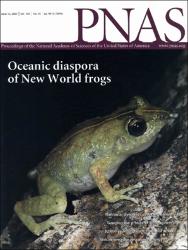/admin/item?itemID=23a4e24e-1b59-48de-b825-cc0ebe0de60f
Major Caribbean and Central American frog faunas originated by ancient oceanic dispersal

View/
Type of Access
OpenMaterial Type
ArticleType of Content
Scientific researchLanguage
EnglishCollection
- Investigación ambiental [1743]
Metadata
Show full item record| Abstract: | Approximately one-half of all species of amphibians occur in the New World tropics, which includes South America, Middle America, and the West Indies. Of those, 27% (801 species) belong to a large assemblage, the eleutherodactyline frogs, which breed out of water and lay eggs that undergo direct development on land. Their wide distribution and mode of reproduction offer potential for resolving questions in evolution, ecology, and conservation. However, progress in all of these fields has been hindered by a poor understanding of their evolutionary relationships. As a result, most of the species have been placed in a single genus, Eleutherodactylus, which is the largest among vertebrates. Our DNA sequence analysis of a major fraction of eleutherodactyline diversity revealed three large radiations of species with unexpected geographic isolation: a South American Clade (393 sp.), a Caribbean Clade (171 sp.), and a Middle American Clade (111 sp.). Molecular clock analyses reject the prevailing hypothesis that these frogs arose from land connections with North and South America and their subsequent fragmentation in the Late Cretaceous (80–70 Mya). Origin by dispersal, probably over water from South America in the early Cenozoic (47–29 million years ago, Mya), is more likely. |
| Author(s): | Heinicke, Matthew P.
Duellman, William E. Hedges, S. Blair |
| Date: | 2007 |
| Published: | Proceedings of the National Academy of Sciences, 104(24), 10092-10097 |
| Citation: | Heinicke, M. P., Duellman, W. E., & Hedges, S. B. (2007). Major Caribbean and Central American frog faunas originated by ancient oceanic dispersal. Proceedings of the National Academy of Sciences, 104(24), 10092-10097. Recuperado de: |
| URI: | https://bvearmb.do/handle/123456789/1691
|
